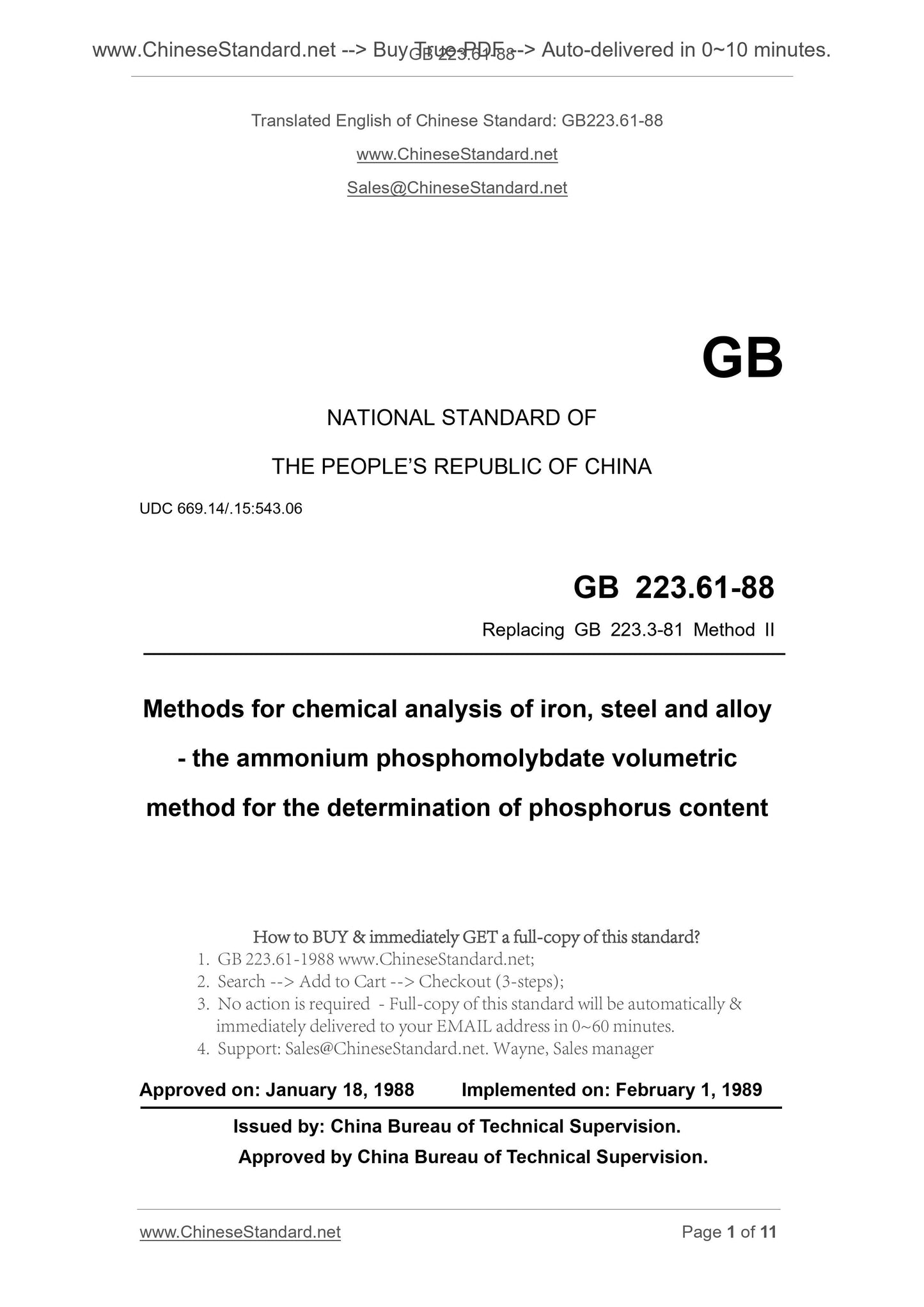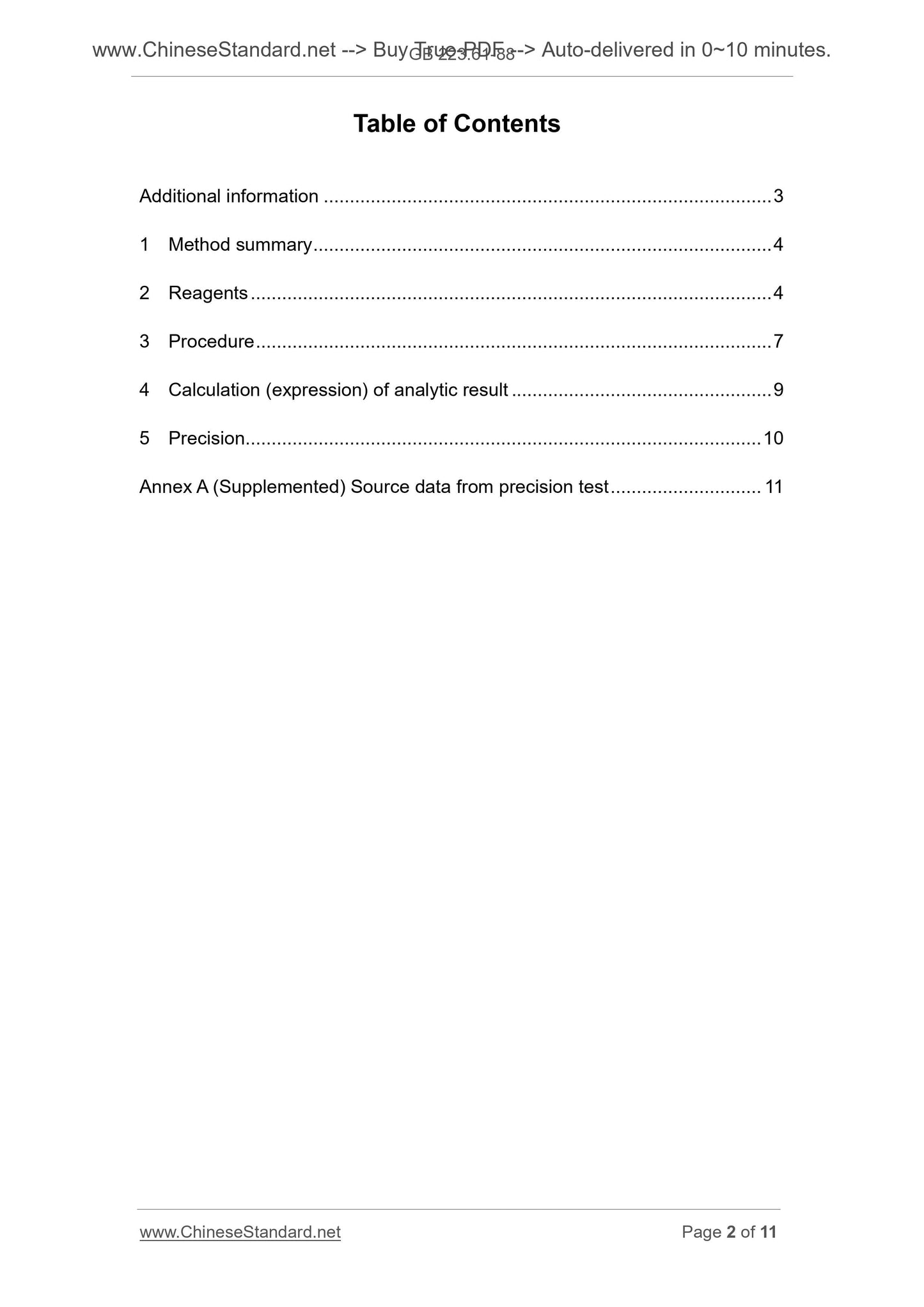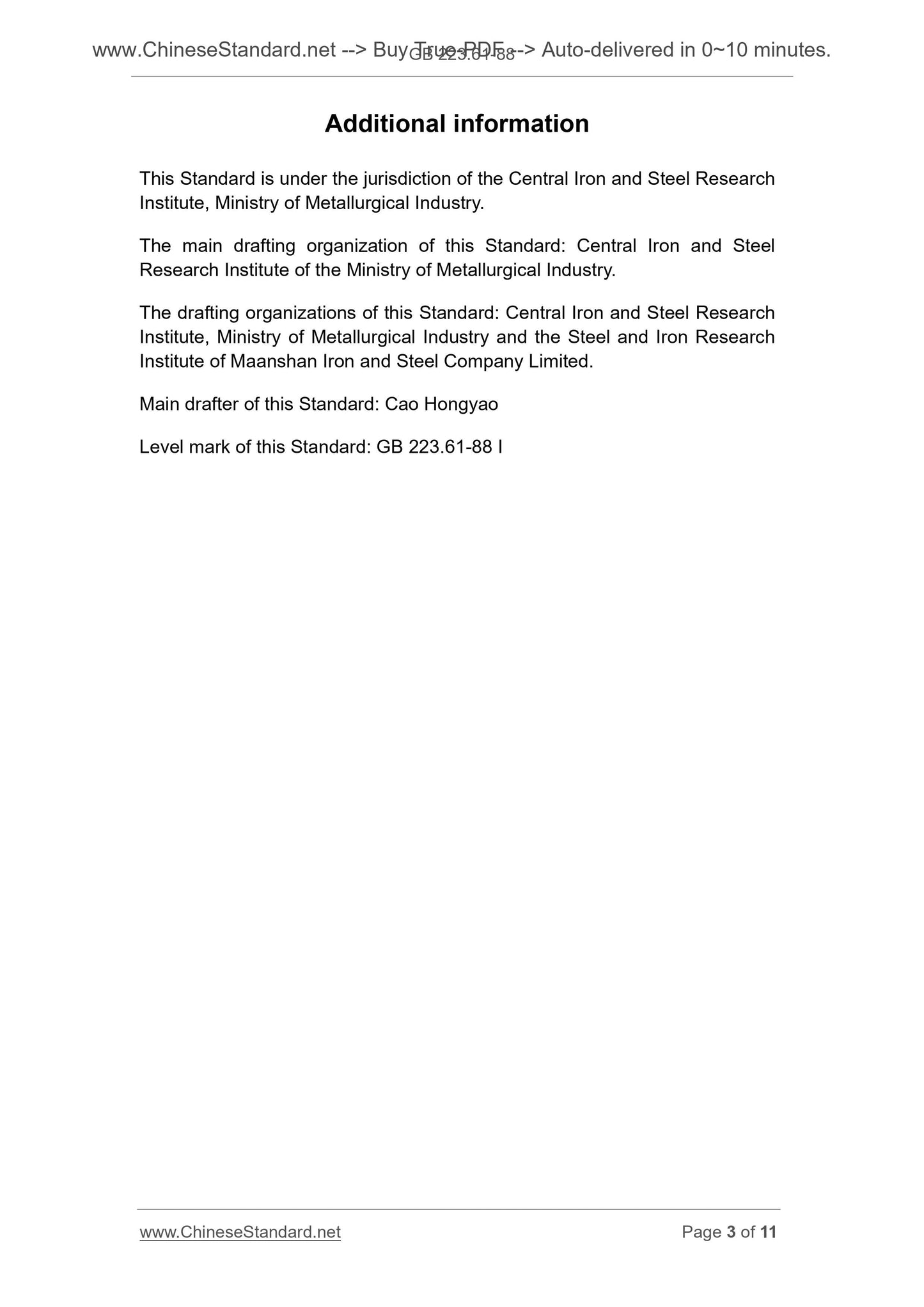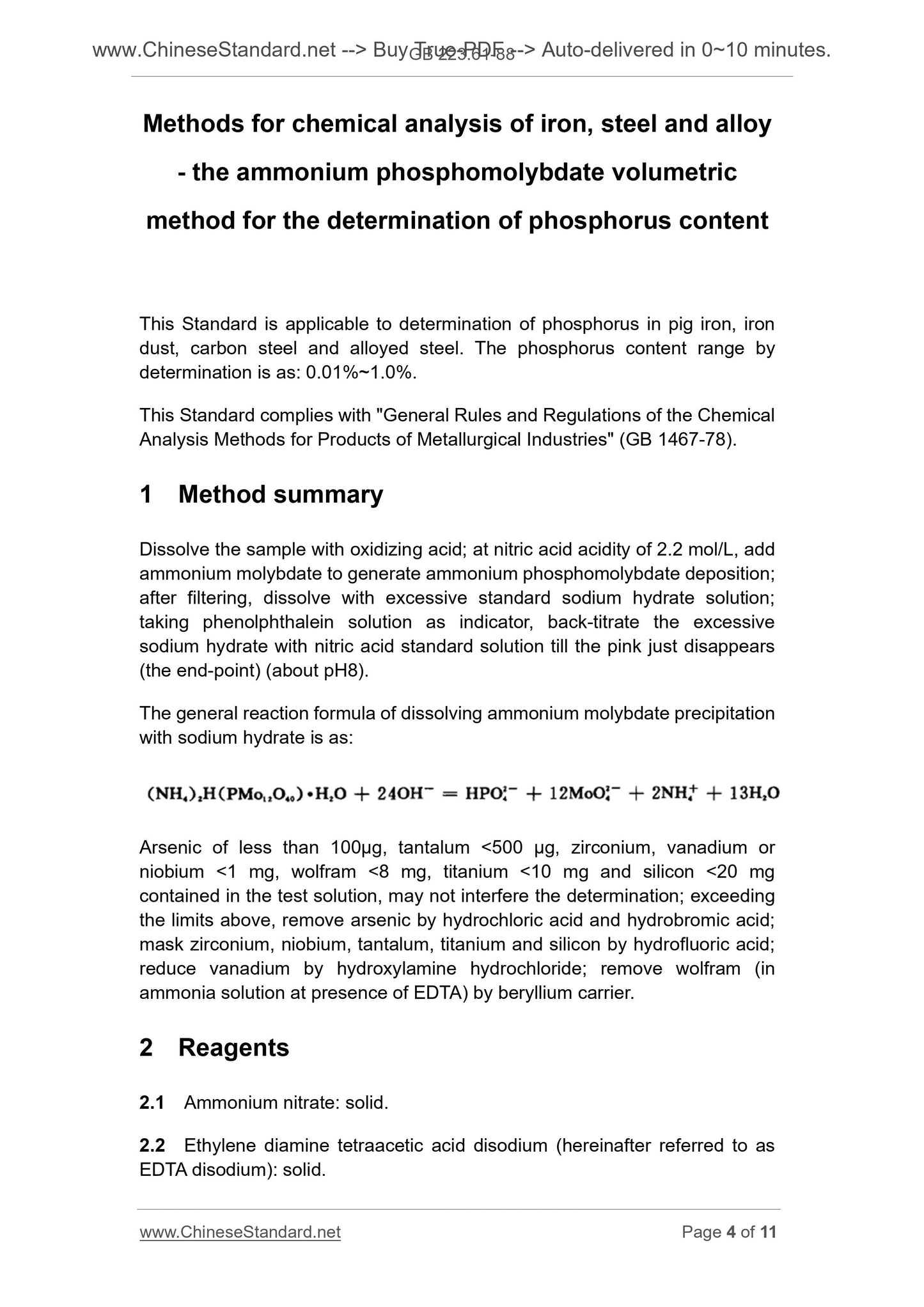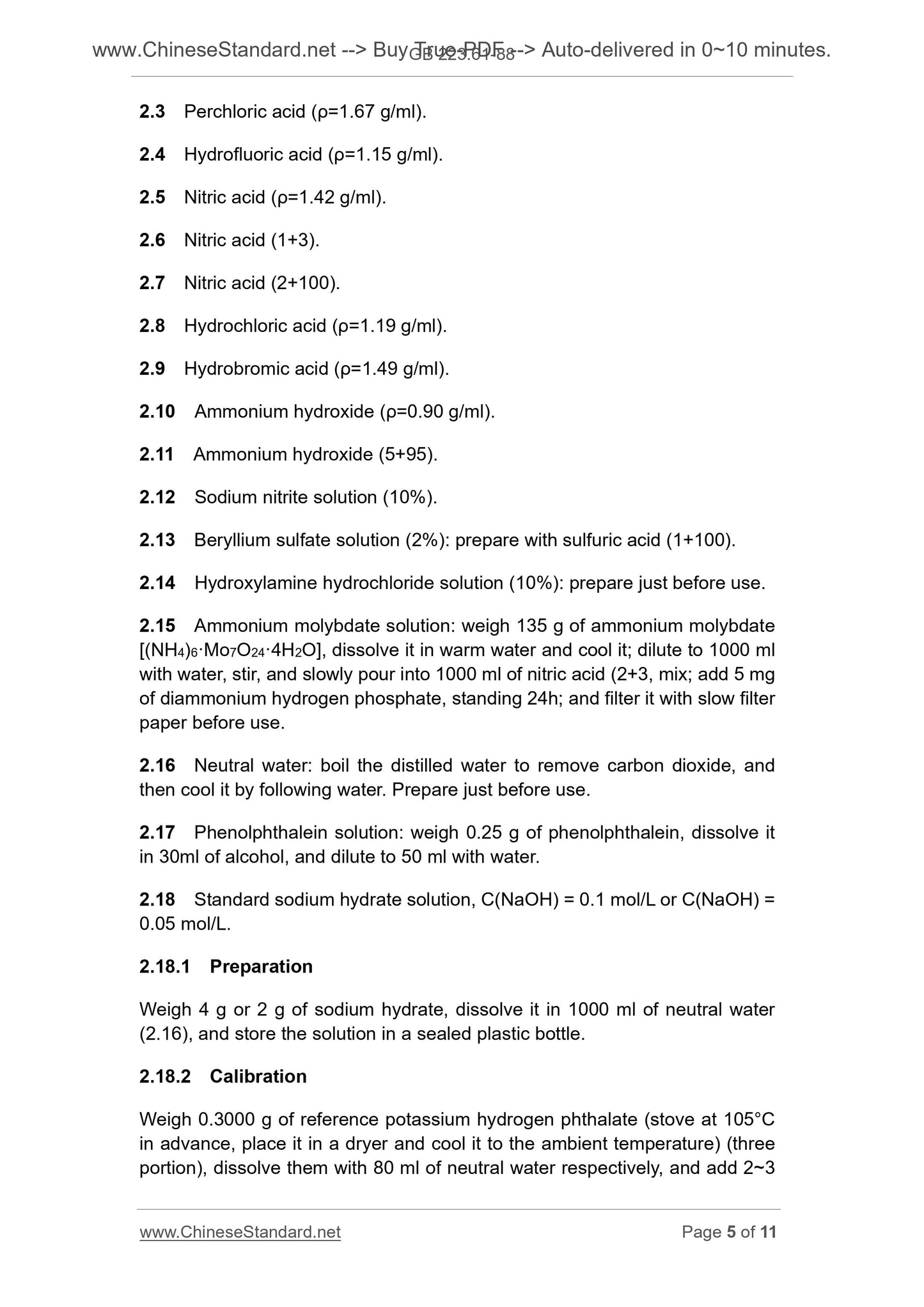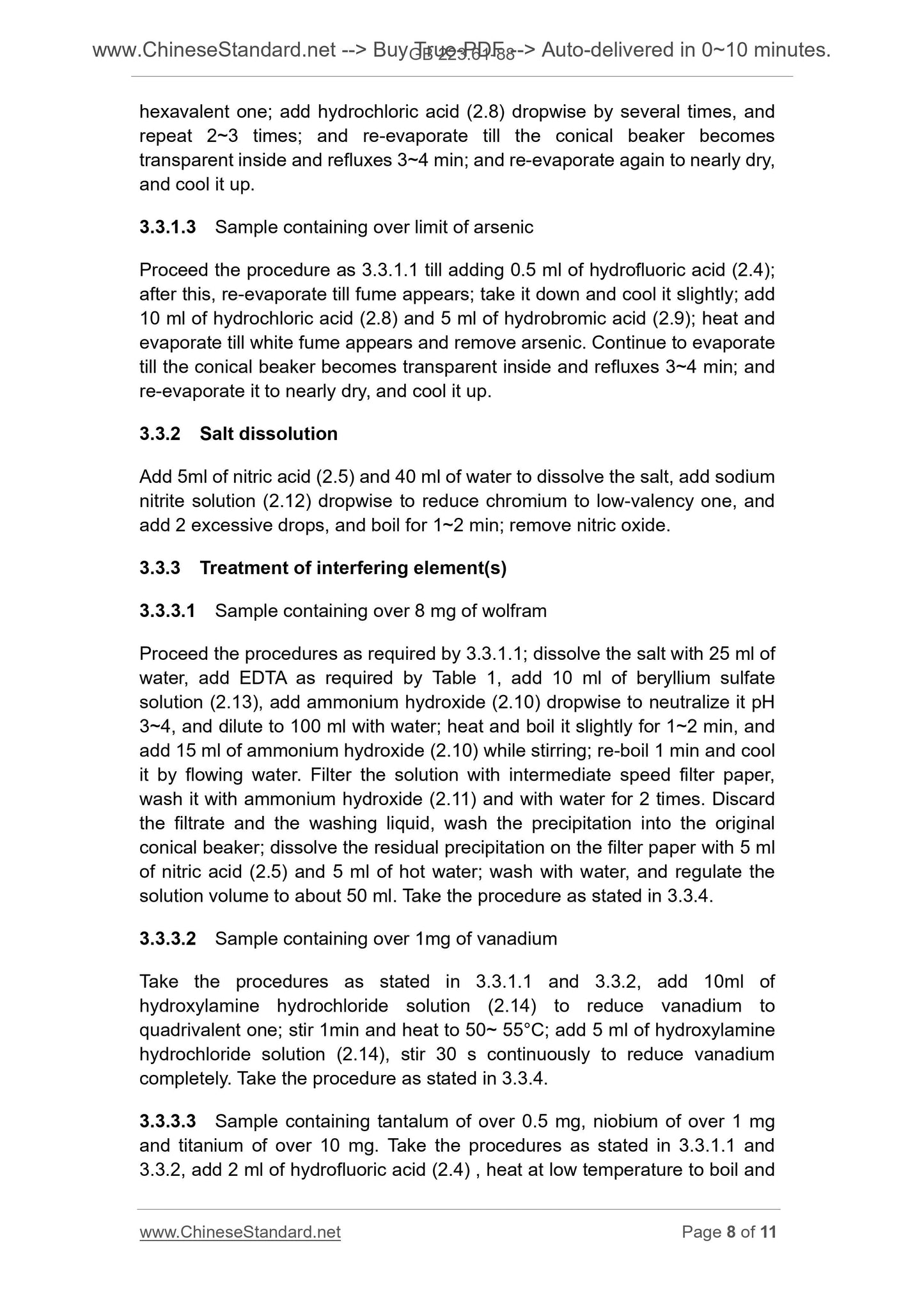1
/
of
6
www.ChineseStandard.us -- Field Test Asia Pte. Ltd.
GB/T 223.61-1988 English PDF (GB/T223.61-1988)
GB/T 223.61-1988 English PDF (GB/T223.61-1988)
Regular price
$70.00
Regular price
Sale price
$70.00
Unit price
/
per
Shipping calculated at checkout.
Couldn't load pickup availability
GB/T 223.61-1988: Methods for chemical analysis of iron, steel and alloy - The ammonium phosphomolybdate volumetric method for the determination of phosphorus content
Delivery: 9 seconds. Download (& Email) true-PDF + Invoice.
Get Quotation: Click GB/T 223.61-1988 (Self-service in 1-minute)
Historical versions (Master-website): GB/T 223.61-1988
Preview True-PDF (Reload/Scroll-down if blank)
GB 223.61-88
GB
NATIONAL STANDARD OF
THE PEOPLE’S REPUBLIC OF CHINA
UDC 669.14/.15.543.06
Replacing GB 223.3-81 Method II
Methods for chemical analysis of iron, steel and alloy
- the ammonium phosphomolybdate volumetric
method for the determination of phosphorus content
APPROVED ON. JANUARY 18, 1988
IMPLEMENTED ON. FEBRUARY 1, 1989
Issued by. China Bureau of Technical Supervision.
Approved by China Bureau of Technical Supervision.
Table of Contents
Additional information ... 3
1 Method summary ... 4
2 Reagents ... 4
3 Procedure ... 7
4 Calculation (expression) of analytic result ... 9
5 Precision... 10
Annex A (Supplemented) Source data from precision test ... 11
Additional information
This Standard is under the jurisdiction of the Central Iron and Steel Research
Institute, Ministry of Metallurgical Industry.
The main drafting organization of this Standard. Central Iron and Steel
Research Institute of the Ministry of Metallurgical Industry.
The drafting organizations of this Standard. Central Iron and Steel Research
Institute, Ministry of Metallurgical Industry and the Steel and Iron Research
Institute of Maanshan Iron and Steel Company Limited.
Main drafter of this Standard. Cao Hongyao
Level mark of this Standard. GB 223.61-88 I
Methods for chemical analysis of iron, steel and alloy
- the ammonium phosphomolybdate volumetric
method for the determination of phosphorus content
This Standard is applicable to determination of phosphorus in pig iron, iron
dust, carbon steel and alloyed steel. The phosphorus content range by
determination is as. 0.01%~1.0%.
This Standard complies with "General Rules and Regulations of the Chemical
Analysis Methods for Products of Metallurgical Industries" (GB 1467-78).
1 Method summary
Dissolve the sample with oxidizing acid; at nitric acid acidity of 2.2 mol/L, add
ammonium molybdate to generate ammonium phosphomolybdate deposition;
after filtering, dissolve with excessive standard sodium hydrate solution;
taking phenolphthalein solution as indicator, back-titrate the excessive
sodium hydrate with nitric acid standard solution till the pink just disappears
(the end-point) (about pH8).
The general reaction formula of dissolving ammonium molybdate precipitation
with sodium hydrate is as.
Arsenic of less than 100μg, tantalum < 500 μg, zirconium, vanadium or
niobium < 1 mg, wolfram < 8 mg, titanium < 10 mg and silicon < 20 mg
contained in the test solution, may not interfere the determination; exceeding
the limits above, remove arsenic by hydrochloric acid and hydrobromic acid;
mask zirconium, niobium, tantalum, titanium and silicon by hydrofluoric acid;
reduce vanadium by hydroxylamine hydrochloride; remove wolfram (in
ammonia solution at presence of EDTA) by beryllium carrier.
2 Reagents
2.1 Ammonium nitrate. solid.
2.2 Ethylene diamine tetraacetic acid disodium (hereinafter referred to as
EDTA disodium). solid.
2.3 Perchloric acid (ρ=1.67 g/ml).
2.4 Hydrofluoric acid (ρ=1.15 g/ml).
2.5 Nitric acid (ρ=1.42 g/ml).
2.6 Nitric acid (1+3).
2.7 Nitric acid (2+100).
2.8 Hydrochloric acid (ρ=1.19 g/ml).
2.9 Hydrobromic acid (ρ=1.49 g/ml).
2.10 Ammonium hydroxide (ρ=0.90 g/ml).
2.11 Ammonium hydroxide (5+95).
2.12 Sodium nitrite solution (10%).
2.13 Beryllium sulfate solution (2%). prepare with sulfuric acid (1+100).
2.14 Hydroxylamine hydrochloride solution (10%). prepare just before use.
2.15 Ammonium molybdate solution. weigh 135 g of ammonium molybdate
[(NH4)6·Mo7O24·4H2O], dissolve it in warm water and cool it; dilute to 1000 ml
with water, stir, and slowly pour into 1000 ml of nitric acid (2+3, mix; add 5 mg
of diammonium hydrogen phosphate, standing 24h; and filter it with slow filter
paper before use.
2.16 Neutral water. boil the distilled water to remove carbon dioxide, and
then cool it by following water. Prepare just before use.
2.17 Phenolphthalein solution. weigh 0.25 g of phenolphthalein, dissolve it
in 30ml of alcohol, and dilute to 50 ml with water.
2.18 Standard sodium hydrate solution, C(NaOH) = 0.1 mol/L or C(NaOH) =
0.05 mol/L.
2.18.1 Preparation
Weigh 4 g or 2 g of sodium hydrate, dissolve it in 1000 ml of neutral water
(2.16), and store the solution in a sealed plastic bottle.
2.18.2 Calibration
Weigh 0.3000 g of reference potassium hydrogen phthalate (stove at 105°C
in advance, place it in a dryer and cool it to the ambient temperature) (three
portion), dissolve them with 80 ml of neutral water respectively, and add 2~3
drops of phenolphthalein solution (2.17) respectively; titrate them with
standard sodium hydrate solution (2.18) to light red; the maximum difference
of the amount consumption (mL) of standard sodium hydrate solution for the
three solutions shall not exceed 0.05ml, the mean shall be taken, and the
concentration of standard sodium hydrate solution is taken according to the
formula below.
Where,
C - The mass concentration of the standard sodium hydrate solution, mol/l;
m - The mass of potassium hydrogen phthalate weighed, g;
V - The mean volume of the standard sodium hydrate solution consumed for
calibration, ml;
204.22 - The mole mass of potassium hydrogen phthalate, g/mol.
2.19 Standard nitric acid solution, C(HNO3)=0.1 mol/l or C(HNO3)=0.05
mol/l.
2.19.1 Preparation
Pipette 6.5 ml or 3.3 ml of nitric acid (2.5) that has been remove nitric oxide
and cooled up, and dilute it to 1000 ml with water, mix.
2.19.2 Calibration
Pipette 25.00 ml of standard sodium hydrate solution (2.18) (three portions),
add 50 ml of neutral water (2.16) and 3 drops of phenolphthalein (2.17)
respectively, titrate them with standard nitric acid solution (2.19.1)
respectively till the red disappears; the maximum difference of the
consumptions of standard nitric acid solutions (2.19.1) for three portions of
the solution shall not exceed 0.05 mL, and the mean (V1) shall be taken
according to the formula below.
Where,
K - The coefficient for reduction of standard nitric acid solution to standard
sodium hydrate solution;
V - The mean volume of standard nitric acid solution used for titrating, ml;
25.00 - The volume of the standard sodium hydrate solution (2.18) pipetted,
ml.
3 Procedure
3.1 Sample Amount
The sample shall be selected as required by Table 1.
Table 1
3.2 Blank Test
Carry out the blank test in parallel with the test with the sample.
3.3 Determination
3.3.1 Sample dissolution
3.3.1.1 Common sample
Place the sample (3.1) into a 300 ml conical beaker, and add nitric acid as
required by Table 1, and heat for dissolving [for indissoluble sample, add
appropriate amount of hydrochloric acid (2.8) dropwise to promote
dissolution]. Add perchloric acid as required by Table 1, heat it till the fume
appears, slightly cool, add 0.5 ml of hydrofluoric acid (2.4) dropwise, and heat
again and make it fume till the conical beaker becomes transparent inside
and refluxes 3~ 4 min (it the sample contains over 10 mg of manganese, add
more 7~8 ml of perchloric acid (2.3), heat and make it fume till the conical
beaker becomes transparent inside and refluxes 20~25 min, so as to oxidize
phosphorus completely); and continue to evaporate it to nearly dry, and cool it
up.
3.3.1.2 Sample containing over 50 mg of chromium
Proceed the procedure as 3.3.1.1 till adding 0.5 ml of oxygen-fluorine acid
(2.4); after this, re-evaporate and make it fume till chromium is oxidized to
hexavalent one; add hydrochloric acid (2.8) dropwise by several times, and
repeat 2~3 times; and re-evaporate till the conical beaker becomes
transparent inside and refluxes 3~4 min; and re-evaporate again to nearly dry,
and cool it up.
3.3.1.3 Sample containing over limit of arsenic
Proceed the procedure as 3.3.1.1 till adding 0.5 ml of hydrofluoric acid (2.4);
after this, re-evaporate till fume appears; take it down and cool it slightly; add
10 ml of hydrochloric acid (2.8) and 5 ml of hydrobromic acid (2.9); heat and
evaporate till white fume appears and remove arsenic. Continue to evaporate
till the conical beaker becomes transparent inside and refluxes 3~4 min; and
re-evaporate it to nearly dry, and cool it up.
3.3.2 Salt dissolution
Add 5ml of nitric acid (2.5) and 40 ml of water to dissolve the salt, add sodium
nitrite solution (2.12) dropwise to reduce chromium to low-valency one, and
add 2 excessive drops, and boil for 1~2 min; remove nitric oxide.
3.3.3 Treatment of interfering element(s)
3.3.3.1 Sample containing over 8 mg of wolfram
Proceed the procedures as required by 3.3.1.1; dissolve the salt with 25 ml of
water, add EDTA as required by Table 1, add 10 ml of beryllium sulfate
solution (2.13), add ammonium hydroxide (2.10) dropwise to neutralize it pH
3~4, and dilute to 100 ml with water; heat and boil it slightly for 1~2 min, and
add 15 ml of ammonium hydroxide (2.10) while stirring; re-boil 1 min and cool
it by flowing water. Filter the solution with intermediate speed filter paper,
wash it with ammonium hydroxide (2.11) and with water for 2 times. Discard
the filtrate and the washing liquid, wash the precipitation into the original
conical beaker; dissolve the residual precipitation on the filter paper with 5 ml
of nitric acid (2.5) a...
GB 223.61-88
GB
NATIONAL STANDARD OF
THE PEOPLE’S REPUBLIC OF CHINA
UDC 669.14/.15.543.06
Replacing GB 223.3-81 Method II
Methods for chemical analysis of iron, steel and alloy
- the ammonium phosphomolybdate volumetric
method for the determination of phosphorus content
APPROVED ON. JANUARY 18, 1988
IMPLEMENTED ON. FEBRUARY 1, 1989
Issued by. China Bureau of Technical Supervision.
Approved by China Bureau of Technical Supervision.
Table of Contents
Additional information ... 3
1 Method summary ... 4
2 Reagents ... 4
3 Procedure ... 7
4 Calculation (expression) of analytic result ... 9
5 Precision... 10
Annex A (Supplemented) Source data from precision test ... 11
Additional information
This Standard is under the jurisdiction of the Central Iron and Steel Research
Institute, Ministry of Metallurgical Industry.
The main drafting organization of this Standard. Central Iron and Steel
Research Institute of the Ministry of Metallurgical Industry.
The drafting organizations of this Standard. Central Iron and Steel Research
Institute, Ministry of Metallurgical Industry and the Steel and Iron Research
Institute of Maanshan Iron and Steel Company Limited.
Main drafter of this Standard. Cao Hongyao
Level mark of this Standard. GB 223.61-88 I
Methods for chemical analysis of iron, steel and alloy
- the ammonium phosphomolybdate volumetric
method for the determination of phosphorus content
This Standard is applicable to determination of phosphorus in pig iron, iron
dust, carbon steel and alloyed steel. The phosphorus content range by
determination is as. 0.01%~1.0%.
This Standard complies with "General Rules and Regulations of the Chemical
Analysis Methods for Products of Metallurgical Industries" (GB 1467-78).
1 Method summary
Dissolve the sample with oxidizing acid; at nitric acid acidity of 2.2 mol/L, add
ammonium molybdate to generate ammonium phosphomolybdate deposition;
after filtering, dissolve with excessive standard sodium hydrate solution;
taking phenolphthalein solution as indicator, back-titrate the excessive
sodium hydrate with nitric acid standard solution till the pink just disappears
(the end-point) (about pH8).
The general reaction formula of dissolving ammonium molybdate precipitation
with sodium hydrate is as.
Arsenic of less than 100μg, tantalum < 500 μg, zirconium, vanadium or
niobium < 1 mg, wolfram < 8 mg, titanium < 10 mg and silicon < 20 mg
contained in the test solution, may not interfere the determination; exceeding
the limits above, remove arsenic by hydrochloric acid and hydrobromic acid;
mask zirconium, niobium, tantalum, titanium and silicon by hydrofluoric acid;
reduce vanadium by hydroxylamine hydrochloride; remove wolfram (in
ammonia solution at presence of EDTA) by beryllium carrier.
2 Reagents
2.1 Ammonium nitrate. solid.
2.2 Ethylene diamine tetraacetic acid disodium (hereinafter referred to as
EDTA disodium). solid.
2.3 Perchloric acid (ρ=1.67 g/ml).
2.4 Hydrofluoric acid (ρ=1.15 g/ml).
2.5 Nitric acid (ρ=1.42 g/ml).
2.6 Nitric acid (1+3).
2.7 Nitric acid (2+100).
2.8 Hydrochloric acid (ρ=1.19 g/ml).
2.9 Hydrobromic acid (ρ=1.49 g/ml).
2.10 Ammonium hydroxide (ρ=0.90 g/ml).
2.11 Ammonium hydroxide (5+95).
2.12 Sodium nitrite solution (10%).
2.13 Beryllium sulfate solution (2%). prepare with sulfuric acid (1+100).
2.14 Hydroxylamine hydrochloride solution (10%). prepare just before use.
2.15 Ammonium molybdate solution. weigh 135 g of ammonium molybdate
[(NH4)6·Mo7O24·4H2O], dissolve it in warm water and cool it; dilute to 1000 ml
with water, stir, and slowly pour into 1000 ml of nitric acid (2+3, mix; add 5 mg
of diammonium hydrogen phosphate, standing 24h; and filter it with slow filter
paper before use.
2.16 Neutral water. boil the distilled water to remove carbon dioxide, and
then cool it by following water. Prepare just before use.
2.17 Phenolphthalein solution. weigh 0.25 g of phenolphthalein, dissolve it
in 30ml of alcohol, and dilute to 50 ml with water.
2.18 Standard sodium hydrate solution, C(NaOH) = 0.1 mol/L or C(NaOH) =
0.05 mol/L.
2.18.1 Preparation
Weigh 4 g or 2 g of sodium hydrate, dissolve it in 1000 ml of neutral water
(2.16), and store the solution in a sealed plastic bottle.
2.18.2 Calibration
Weigh 0.3000 g of reference potassium hydrogen phthalate (stove at 105°C
in advance, place it in a dryer and cool it to the ambient temperature) (three
portion), dissolve them with 80 ml of neutral water respectively, and add 2~3
drops of phenolphthalein solution (2.17) respectively; titrate them with
standard sodium hydrate solution (2.18) to light red; the...
Delivery: 9 seconds. Download (& Email) true-PDF + Invoice.
Get Quotation: Click GB/T 223.61-1988 (Self-service in 1-minute)
Historical versions (Master-website): GB/T 223.61-1988
Preview True-PDF (Reload/Scroll-down if blank)
GB 223.61-88
GB
NATIONAL STANDARD OF
THE PEOPLE’S REPUBLIC OF CHINA
UDC 669.14/.15.543.06
Replacing GB 223.3-81 Method II
Methods for chemical analysis of iron, steel and alloy
- the ammonium phosphomolybdate volumetric
method for the determination of phosphorus content
APPROVED ON. JANUARY 18, 1988
IMPLEMENTED ON. FEBRUARY 1, 1989
Issued by. China Bureau of Technical Supervision.
Approved by China Bureau of Technical Supervision.
Table of Contents
Additional information ... 3
1 Method summary ... 4
2 Reagents ... 4
3 Procedure ... 7
4 Calculation (expression) of analytic result ... 9
5 Precision... 10
Annex A (Supplemented) Source data from precision test ... 11
Additional information
This Standard is under the jurisdiction of the Central Iron and Steel Research
Institute, Ministry of Metallurgical Industry.
The main drafting organization of this Standard. Central Iron and Steel
Research Institute of the Ministry of Metallurgical Industry.
The drafting organizations of this Standard. Central Iron and Steel Research
Institute, Ministry of Metallurgical Industry and the Steel and Iron Research
Institute of Maanshan Iron and Steel Company Limited.
Main drafter of this Standard. Cao Hongyao
Level mark of this Standard. GB 223.61-88 I
Methods for chemical analysis of iron, steel and alloy
- the ammonium phosphomolybdate volumetric
method for the determination of phosphorus content
This Standard is applicable to determination of phosphorus in pig iron, iron
dust, carbon steel and alloyed steel. The phosphorus content range by
determination is as. 0.01%~1.0%.
This Standard complies with "General Rules and Regulations of the Chemical
Analysis Methods for Products of Metallurgical Industries" (GB 1467-78).
1 Method summary
Dissolve the sample with oxidizing acid; at nitric acid acidity of 2.2 mol/L, add
ammonium molybdate to generate ammonium phosphomolybdate deposition;
after filtering, dissolve with excessive standard sodium hydrate solution;
taking phenolphthalein solution as indicator, back-titrate the excessive
sodium hydrate with nitric acid standard solution till the pink just disappears
(the end-point) (about pH8).
The general reaction formula of dissolving ammonium molybdate precipitation
with sodium hydrate is as.
Arsenic of less than 100μg, tantalum < 500 μg, zirconium, vanadium or
niobium < 1 mg, wolfram < 8 mg, titanium < 10 mg and silicon < 20 mg
contained in the test solution, may not interfere the determination; exceeding
the limits above, remove arsenic by hydrochloric acid and hydrobromic acid;
mask zirconium, niobium, tantalum, titanium and silicon by hydrofluoric acid;
reduce vanadium by hydroxylamine hydrochloride; remove wolfram (in
ammonia solution at presence of EDTA) by beryllium carrier.
2 Reagents
2.1 Ammonium nitrate. solid.
2.2 Ethylene diamine tetraacetic acid disodium (hereinafter referred to as
EDTA disodium). solid.
2.3 Perchloric acid (ρ=1.67 g/ml).
2.4 Hydrofluoric acid (ρ=1.15 g/ml).
2.5 Nitric acid (ρ=1.42 g/ml).
2.6 Nitric acid (1+3).
2.7 Nitric acid (2+100).
2.8 Hydrochloric acid (ρ=1.19 g/ml).
2.9 Hydrobromic acid (ρ=1.49 g/ml).
2.10 Ammonium hydroxide (ρ=0.90 g/ml).
2.11 Ammonium hydroxide (5+95).
2.12 Sodium nitrite solution (10%).
2.13 Beryllium sulfate solution (2%). prepare with sulfuric acid (1+100).
2.14 Hydroxylamine hydrochloride solution (10%). prepare just before use.
2.15 Ammonium molybdate solution. weigh 135 g of ammonium molybdate
[(NH4)6·Mo7O24·4H2O], dissolve it in warm water and cool it; dilute to 1000 ml
with water, stir, and slowly pour into 1000 ml of nitric acid (2+3, mix; add 5 mg
of diammonium hydrogen phosphate, standing 24h; and filter it with slow filter
paper before use.
2.16 Neutral water. boil the distilled water to remove carbon dioxide, and
then cool it by following water. Prepare just before use.
2.17 Phenolphthalein solution. weigh 0.25 g of phenolphthalein, dissolve it
in 30ml of alcohol, and dilute to 50 ml with water.
2.18 Standard sodium hydrate solution, C(NaOH) = 0.1 mol/L or C(NaOH) =
0.05 mol/L.
2.18.1 Preparation
Weigh 4 g or 2 g of sodium hydrate, dissolve it in 1000 ml of neutral water
(2.16), and store the solution in a sealed plastic bottle.
2.18.2 Calibration
Weigh 0.3000 g of reference potassium hydrogen phthalate (stove at 105°C
in advance, place it in a dryer and cool it to the ambient temperature) (three
portion), dissolve them with 80 ml of neutral water respectively, and add 2~3
drops of phenolphthalein solution (2.17) respectively; titrate them with
standard sodium hydrate solution (2.18) to light red; the maximum difference
of the amount consumption (mL) of standard sodium hydrate solution for the
three solutions shall not exceed 0.05ml, the mean shall be taken, and the
concentration of standard sodium hydrate solution is taken according to the
formula below.
Where,
C - The mass concentration of the standard sodium hydrate solution, mol/l;
m - The mass of potassium hydrogen phthalate weighed, g;
V - The mean volume of the standard sodium hydrate solution consumed for
calibration, ml;
204.22 - The mole mass of potassium hydrogen phthalate, g/mol.
2.19 Standard nitric acid solution, C(HNO3)=0.1 mol/l or C(HNO3)=0.05
mol/l.
2.19.1 Preparation
Pipette 6.5 ml or 3.3 ml of nitric acid (2.5) that has been remove nitric oxide
and cooled up, and dilute it to 1000 ml with water, mix.
2.19.2 Calibration
Pipette 25.00 ml of standard sodium hydrate solution (2.18) (three portions),
add 50 ml of neutral water (2.16) and 3 drops of phenolphthalein (2.17)
respectively, titrate them with standard nitric acid solution (2.19.1)
respectively till the red disappears; the maximum difference of the
consumptions of standard nitric acid solutions (2.19.1) for three portions of
the solution shall not exceed 0.05 mL, and the mean (V1) shall be taken
according to the formula below.
Where,
K - The coefficient for reduction of standard nitric acid solution to standard
sodium hydrate solution;
V - The mean volume of standard nitric acid solution used for titrating, ml;
25.00 - The volume of the standard sodium hydrate solution (2.18) pipetted,
ml.
3 Procedure
3.1 Sample Amount
The sample shall be selected as required by Table 1.
Table 1
3.2 Blank Test
Carry out the blank test in parallel with the test with the sample.
3.3 Determination
3.3.1 Sample dissolution
3.3.1.1 Common sample
Place the sample (3.1) into a 300 ml conical beaker, and add nitric acid as
required by Table 1, and heat for dissolving [for indissoluble sample, add
appropriate amount of hydrochloric acid (2.8) dropwise to promote
dissolution]. Add perchloric acid as required by Table 1, heat it till the fume
appears, slightly cool, add 0.5 ml of hydrofluoric acid (2.4) dropwise, and heat
again and make it fume till the conical beaker becomes transparent inside
and refluxes 3~ 4 min (it the sample contains over 10 mg of manganese, add
more 7~8 ml of perchloric acid (2.3), heat and make it fume till the conical
beaker becomes transparent inside and refluxes 20~25 min, so as to oxidize
phosphorus completely); and continue to evaporate it to nearly dry, and cool it
up.
3.3.1.2 Sample containing over 50 mg of chromium
Proceed the procedure as 3.3.1.1 till adding 0.5 ml of oxygen-fluorine acid
(2.4); after this, re-evaporate and make it fume till chromium is oxidized to
hexavalent one; add hydrochloric acid (2.8) dropwise by several times, and
repeat 2~3 times; and re-evaporate till the conical beaker becomes
transparent inside and refluxes 3~4 min; and re-evaporate again to nearly dry,
and cool it up.
3.3.1.3 Sample containing over limit of arsenic
Proceed the procedure as 3.3.1.1 till adding 0.5 ml of hydrofluoric acid (2.4);
after this, re-evaporate till fume appears; take it down and cool it slightly; add
10 ml of hydrochloric acid (2.8) and 5 ml of hydrobromic acid (2.9); heat and
evaporate till white fume appears and remove arsenic. Continue to evaporate
till the conical beaker becomes transparent inside and refluxes 3~4 min; and
re-evaporate it to nearly dry, and cool it up.
3.3.2 Salt dissolution
Add 5ml of nitric acid (2.5) and 40 ml of water to dissolve the salt, add sodium
nitrite solution (2.12) dropwise to reduce chromium to low-valency one, and
add 2 excessive drops, and boil for 1~2 min; remove nitric oxide.
3.3.3 Treatment of interfering element(s)
3.3.3.1 Sample containing over 8 mg of wolfram
Proceed the procedures as required by 3.3.1.1; dissolve the salt with 25 ml of
water, add EDTA as required by Table 1, add 10 ml of beryllium sulfate
solution (2.13), add ammonium hydroxide (2.10) dropwise to neutralize it pH
3~4, and dilute to 100 ml with water; heat and boil it slightly for 1~2 min, and
add 15 ml of ammonium hydroxide (2.10) while stirring; re-boil 1 min and cool
it by flowing water. Filter the solution with intermediate speed filter paper,
wash it with ammonium hydroxide (2.11) and with water for 2 times. Discard
the filtrate and the washing liquid, wash the precipitation into the original
conical beaker; dissolve the residual precipitation on the filter paper with 5 ml
of nitric acid (2.5) a...
GB 223.61-88
GB
NATIONAL STANDARD OF
THE PEOPLE’S REPUBLIC OF CHINA
UDC 669.14/.15.543.06
Replacing GB 223.3-81 Method II
Methods for chemical analysis of iron, steel and alloy
- the ammonium phosphomolybdate volumetric
method for the determination of phosphorus content
APPROVED ON. JANUARY 18, 1988
IMPLEMENTED ON. FEBRUARY 1, 1989
Issued by. China Bureau of Technical Supervision.
Approved by China Bureau of Technical Supervision.
Table of Contents
Additional information ... 3
1 Method summary ... 4
2 Reagents ... 4
3 Procedure ... 7
4 Calculation (expression) of analytic result ... 9
5 Precision... 10
Annex A (Supplemented) Source data from precision test ... 11
Additional information
This Standard is under the jurisdiction of the Central Iron and Steel Research
Institute, Ministry of Metallurgical Industry.
The main drafting organization of this Standard. Central Iron and Steel
Research Institute of the Ministry of Metallurgical Industry.
The drafting organizations of this Standard. Central Iron and Steel Research
Institute, Ministry of Metallurgical Industry and the Steel and Iron Research
Institute of Maanshan Iron and Steel Company Limited.
Main drafter of this Standard. Cao Hongyao
Level mark of this Standard. GB 223.61-88 I
Methods for chemical analysis of iron, steel and alloy
- the ammonium phosphomolybdate volumetric
method for the determination of phosphorus content
This Standard is applicable to determination of phosphorus in pig iron, iron
dust, carbon steel and alloyed steel. The phosphorus content range by
determination is as. 0.01%~1.0%.
This Standard complies with "General Rules and Regulations of the Chemical
Analysis Methods for Products of Metallurgical Industries" (GB 1467-78).
1 Method summary
Dissolve the sample with oxidizing acid; at nitric acid acidity of 2.2 mol/L, add
ammonium molybdate to generate ammonium phosphomolybdate deposition;
after filtering, dissolve with excessive standard sodium hydrate solution;
taking phenolphthalein solution as indicator, back-titrate the excessive
sodium hydrate with nitric acid standard solution till the pink just disappears
(the end-point) (about pH8).
The general reaction formula of dissolving ammonium molybdate precipitation
with sodium hydrate is as.
Arsenic of less than 100μg, tantalum < 500 μg, zirconium, vanadium or
niobium < 1 mg, wolfram < 8 mg, titanium < 10 mg and silicon < 20 mg
contained in the test solution, may not interfere the determination; exceeding
the limits above, remove arsenic by hydrochloric acid and hydrobromic acid;
mask zirconium, niobium, tantalum, titanium and silicon by hydrofluoric acid;
reduce vanadium by hydroxylamine hydrochloride; remove wolfram (in
ammonia solution at presence of EDTA) by beryllium carrier.
2 Reagents
2.1 Ammonium nitrate. solid.
2.2 Ethylene diamine tetraacetic acid disodium (hereinafter referred to as
EDTA disodium). solid.
2.3 Perchloric acid (ρ=1.67 g/ml).
2.4 Hydrofluoric acid (ρ=1.15 g/ml).
2.5 Nitric acid (ρ=1.42 g/ml).
2.6 Nitric acid (1+3).
2.7 Nitric acid (2+100).
2.8 Hydrochloric acid (ρ=1.19 g/ml).
2.9 Hydrobromic acid (ρ=1.49 g/ml).
2.10 Ammonium hydroxide (ρ=0.90 g/ml).
2.11 Ammonium hydroxide (5+95).
2.12 Sodium nitrite solution (10%).
2.13 Beryllium sulfate solution (2%). prepare with sulfuric acid (1+100).
2.14 Hydroxylamine hydrochloride solution (10%). prepare just before use.
2.15 Ammonium molybdate solution. weigh 135 g of ammonium molybdate
[(NH4)6·Mo7O24·4H2O], dissolve it in warm water and cool it; dilute to 1000 ml
with water, stir, and slowly pour into 1000 ml of nitric acid (2+3, mix; add 5 mg
of diammonium hydrogen phosphate, standing 24h; and filter it with slow filter
paper before use.
2.16 Neutral water. boil the distilled water to remove carbon dioxide, and
then cool it by following water. Prepare just before use.
2.17 Phenolphthalein solution. weigh 0.25 g of phenolphthalein, dissolve it
in 30ml of alcohol, and dilute to 50 ml with water.
2.18 Standard sodium hydrate solution, C(NaOH) = 0.1 mol/L or C(NaOH) =
0.05 mol/L.
2.18.1 Preparation
Weigh 4 g or 2 g of sodium hydrate, dissolve it in 1000 ml of neutral water
(2.16), and store the solution in a sealed plastic bottle.
2.18.2 Calibration
Weigh 0.3000 g of reference potassium hydrogen phthalate (stove at 105°C
in advance, place it in a dryer and cool it to the ambient temperature) (three
portion), dissolve them with 80 ml of neutral water respectively, and add 2~3
drops of phenolphthalein solution (2.17) respectively; titrate them with
standard sodium hydrate solution (2.18) to light red; the...
Share
